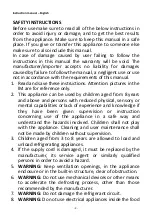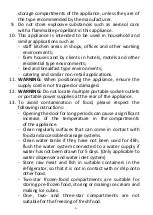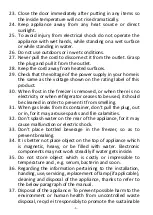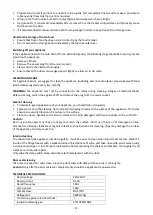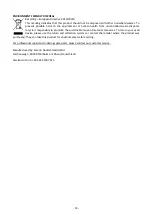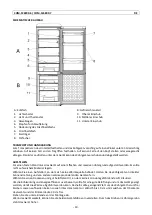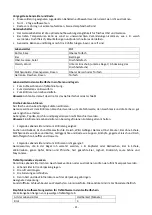
- 10 -
Sea food:
Fatty fish (e.g. salmon, mackerel)
Lean fish (e.g. cod, flounder)
Shrimps
Shucked clams and mussels
Cooked fish
2-3
4-6
12
3-4
1-2
Meat:
Poultry
Beef
Pork
Lamb
Sausage
Ham
Leftovers with meat
9-12
6-12
4-6
6-9
1-2
1-2
2-3
DEFROSTING
Refrigerator compartment defrosts fully automatically.
Freezer compartment does not defrost automatically. A layer of frost in the freezer compartment impairs
refrigeration of the frozen food and increases power consumption. Remove the layer of hoarfrost regularly.
WARNING:
Do not scrape off hoarfrost or ice with a knife or pointed object. Doing this may damage the
refrigerant tubes.
1.
Remove the frozen food and place temporarily in a cool location.
2.
Set the temperature control knob to the 0 position and disconnect the mains plug from the mains socket.
3.
Open the door to accelerate the defrosting process.
4.
Wipe up defrosting water with a cloth or sponge.
5.
Wipe dry the freezer compartment.
6.
Plug in the appliance and adjust the temperature control knob as desired.
7.
Let
the
appliance
work
for
2-3
hours
to
stabilize
at
the
normal
operating
temperature.
8.
Put the frozen food back in the freezer compartment.
HELPFUL HINTS AND TIPS
We recommend that you follow the tips below to save energy.
•
Try to avoid keeping the door open for long periods in order to conserve energy.
•
Ensure the appliance is away from any sources of heat (Direct sunlight, electric oven or cooker etc.)
•
Don't set the temperature colder than necessary.
•
Don't store warm food or evaporating liquid in the appliance.
•
Place the appliance in a well ventilated, humidity free room.
•
Please refer to Installing your new appliance chapter.
•
The “STRUCTURE ILLUSTRATION” shows the correct
combination for the drawers, crisper and shelves, do
not adjust the combination as this is designed to be the most energy efficient configuration.
Hints for fresh food refrigeration
•
Do not place hot food directly into the refrigerator or freezer, the internal temperature will increase
resulting in the compressor having to work harder and will consume more energy.
•
Do cover or wrap the food, particularly if it has a strong flavor.
•
Place food properly so that air can circulate freely around it.
Hints for refrigerator
•
Meat (All Types) Wrap in polythene food: wrap and place on the glass shelf above the vegetable drawer.
Always follow food storage times and use by dates suggested by manufacturers.
•
Cooked food, cold dishes, etc.: They should be covered and may be placed on any shelf.
•
Fruit and vegetables: They should be stored in the special drawer provided.
•
Butter and cheese: Should be wrapped in airtight foil or plastic film wrap.
•
Milk bottles: Should have a lid and be stored in the door racks.
Hints for freezing
•
When first starting-up or after a period out of use, let the appliance run at least 2 hours on the higher settings
before putting food in the compartment.
Summary of Contents for COM-126800.6
Page 1: ...COM 126800 6 COM 126800 7...



